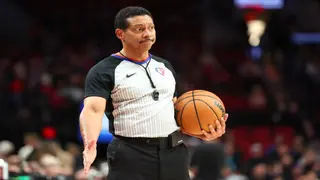How long is a basketball match? Duration, match facts, and all the details
NBA
In less than two weeks' time, more than 2,000 athletes from at least 190 countries will troop to Hungary's capital, Budapest, for the World Athletics Championships.
Kicking off on August 19, the nine-day event will see the athletes compete in 49 events - 24 for each gender and one mixed relay event.

A couple of top stars will headline the event, with Shelly-Ann Fraser-Pryce gunning for a sixth world 100 metres title as Noah Lyles chases a third consecutive 200 metres title.
But ahead of the championships, the world governing body, World Athletics, has approved a series of new rules that will take effect this month. The new changes came about after widespread discussions with elite athletes and coaches.
How long is a basketball match? Duration, match facts, and all the details
NBA
Sports Brief takes a look at what the old rules were and just exactly what has changed.
In the past, an event would continue with an empty lane if an athlete withdrew for whatever reason. Going forward, the empty lane or starting position will be filled by the next-best ranked athlete had had initially missed out.
There won't be redrawing of lanes. The next best-ranked athlete(s) will be on standby to anticipate any possible withdrawals. Four-time Olympic gold medalist, Michael Johnson, has lauded the move.
"No more empty lanes! Long overdue but never too late!" he said on his Twitter page.
This will be the same for field events as well.
The top-ranked athletes in straight events(100 metres/hurdles etc) will get lanes 3,4,5 and 6 as it has been before, but the next-ranked athletes will now get lanes 2 and 7, unlike the 7 and 8 they used before. After the mentioned lanes have been filled, the last ranked athletes will occupy lanes 1 and 8 and not 1 and 2 like how it has been.
What is a decathlon sport? Find all the details explained
Other Sports
In the 200 metres event, the top-ranked athletes will get lanes 5, 6 and 7, the next-ranked athletes will occupy 3, 4 and 8 with the last-ranked athletes getting lanes 1 and 2.
In the 400 metres event, the top-ranked athletes will go in lanes 4,5,6 and 7, the next-ranked athletes will slot into 3 and 8, with the rest getting 1 and 2.
Lane 7 is believed to be a preferred lane for athletes in curved races as it allows the athletes not to run sharp bends.
Normally, athletes will qualify for the next round in middle-distance races after the first heat had been run to judge what the qualification time would be.
This meant that the athletes who went in the first round would be at a disadvantage, given that they were the 'guinea pigs' to set the course for the qualification time.
The 10 tallest volleyball players in the world currently
Volleyball
This has now been scrapped and qualification to the next round will now be based purely on finishing positions. For example, in the 1500 metres, there will be four preliminary heats where six athletes from each of the heats will proceed to the semifinals irrespective of their finishing times.
In the semifinals, there will be two heats, where six athletes from each set will proceed to the final.
This will be applicable for the 1500m, 3000m steeplechase and 5000 metres.
Athletes will now be holed up in a TV room as they wait to know whether they have made it to the next round. The room will be made comfortable as possible with television sets, sofas, access to their coaches and training kits, among other things.
There will also be cameras inside the room to give fans raw reactions from the athletes once they get feedback on their qualification status.
Who is the lowest-paid NBA player in the league right now?
NBA
Previously, athletes will be allowed to run under protest if the start referee had doubts about the false charge start and it had not shown on the World Athletics certified start information system.
"When the reaction time is close to the allowed limit (0.100), any movement may hardly be visible. Now in cases such as these, if the start referee feels the start in question requires further study, the referee may allow the athlete to run under protest."
The referee will make the final decision and relay it to stadium spectators and television audiences. Any decision taken will be subject to appeal.
The event promises to live up to the expectations as A-list athletes head to the Hungarian capital.
Sports Brief looks at what fans should keep an eye on ahead of the kick-off of the 19th event in history.
The sprint races will attract a host of top names with no definitive and outright favourite at the moment.